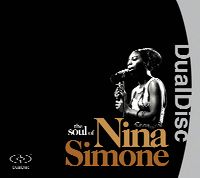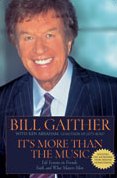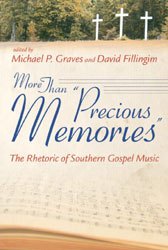• People Get Ready, by Robert Darden, Continuum, 2004
• Uncloudy Day, The Gospel Music Encyclopedia, by Bill Carpenter, Backbeat Books, 2005
• I’ll Take You There: Pop Music and The Urge for Transcendence, by Bill Friskics-Warren, Continuum,
• Various Artists: Uncloudy Days, Artemis Gospel, 2005
Black Gospel is the most influential music America has ever produced. Jazz, blues, folk, rock ‘n’ roll – even hip-hop – all owe an enormous debt to the form, and in every case their roots can be traced back to early spirituals.
 In People Get Ready subtitled A New History of Black Gospel Music Robert Darden argues persuasively that to understand today’s music, one must be aware of Gospel’s colorful history. He traces the form’s evolution from it’s beginnings in West Africa, through the journey to America, slavery, the Civil War and civil rights struggles, right on to today’s stars.
In People Get Ready subtitled A New History of Black Gospel Music Robert Darden argues persuasively that to understand today’s music, one must be aware of Gospel’s colorful history. He traces the form’s evolution from it’s beginnings in West Africa, through the journey to America, slavery, the Civil War and civil rights struggles, right on to today’s stars.
Darden was the Gospel music editor for Billboard for over a decade, and is currently Assistant Professor of English at Baylor University. He’s written over twenty books, and knows his subject well, writing with an undeniable passion for the music he loves. In an interview with CBC last month he argued that the black church appears to be the only place in which the unexpected is embraced – where the Holy Spirit is in control rather than man. There is an openness to the emotional side of faith, which appears stronger and more authentic “than sitting…and listening to polite little hymns and people saying little fifteen minute homilies, as opposed to going for the mountain top.”
Darden posits that as blacks were not allowed inside white churches, they created their own theology, which was closer to first century Christianity that the more racist versions the white population supported. As a result of persecution, the first African American spirituals were often coded, with dual meanings that would never be understood by the white slave owners.
For all his research, Darden never comes across as overly scholarly. The book is an excellent introduction to the music, offering a fascinating overview rather than focusing on specific eras or regions. As such, it whets the reader’s appetite for more information.
 At over 500 pages, Uncloudy Days: The Gospel Music Encyclopedia offers a wealth of information, covering over 650 acts, from the most revered, to obscure one-hit wonders. All the pertinent info, at least as much as can fit into this concise format – is included.
At over 500 pages, Uncloudy Days: The Gospel Music Encyclopedia offers a wealth of information, covering over 650 acts, from the most revered, to obscure one-hit wonders. All the pertinent info, at least as much as can fit into this concise format – is included.
The criteria for inclusion is a bit confusing. For the most part the obvious entries are there, but controversial figures like Rev. Jesse Jackson, Rev. Al Sharpton, late night radio host June Hunt are rather curious. Bishop T.D. Jakes gets almost five pages.
Mainstream acts with connections to the church are well represented. Some have made their faith high profile – Gloria Gaynor, Dion, Al Green, Donna Summer, Lauryn Hill – while others like Mary J. Blige, Whitney Houston, R. Kelly, B.B. King, Prince, Diana Ross, appear to have rather tenuous relationships with the church.
One celebrity included is Kanye West, who last month posed on the cover of Rolling Stone as Jesus Christ, and equated his own struggles with what Christ went through. In an amazing display of an ego out of control, he later told reporters that there needs to be a newly revised version of the Bible, which would included him as a character. “I bring up historical subjects in a way that makes kids want to learn about them. I’m an inspirational speaker…I changed the sound of music more than one time… For all those reasons, I’d be part of the Bible. I’m definitely in the history books already.”
The introduction to Uncloudy Days states the book is “a celebration of every form of gospel music.” It would be better served to focus exclusively on Black Gospel, as the book’s strength is clearly in that area. The few white performers included are somewhat scatter-gunned. Russ Taft, Carman, Jim and Tammy Faye Baker, DC Talk, Phil Driscoll, Bryan Duncan, Amy Grant, The Happy Goodmans, Jake Hess, Kim Hill, Point of Grace and Kathy Troccoli all make the cut, but nothing on influential figures like Keith Green, Mark Heard, Pat Boone, Steve Taylor, Bill Gaither, Buddy & Julie Miller, Randy Stonehill or Barry McGuire. The Christian hip hop and rap scenes are covered, but rock groups from every era- from Love Song, Petra, and Stryper to Living Sacrifice, MxPx, Project 86, and P.O.D. are all conspicuous in their absence..
Christian rock pioneer Larry Norman gets less than a page, but the far more obscure Gay Sisters rate three pages, and the Winan Family collectively garner over thirteen pages.
The exhaustive list of mainstream acts is certainly welcome, but some omissions are rather perplexing. In addition to those already listed, a few key black acts missing include Rev. Gary Davis, The Swan Silvertones (vocalist Claude Jeter gets a short entry), and the Dixie Hummingbirds. Downright puzzling.
Outside of the rather quirky inclusions, Uncloudy Days is a welcome, and essential addition to the bookshelf for anyone interested in Gospel music. Author Bil Carpenter has already gone on record to say that all mistakes brought to his attention will be remedied in the second edition.
A Cd ‘inspired’ by the book is also available. The disc includes 13 gospel tracks by Andre Crouch, Cissy Houston, Mavis Stapes, and other popular acts, plus author Carpenter’s spoken word recitation ‘God Won’t (Hurt You).’ As if to demonstrate how blurred to lines between the secular and sacred are, the Houston track is Marvin Gaye’s ‘How Sweet It Is (To Be Loved By You).’
 Gaye is featured in I’ll Take You There, which looks at various means pop music has employed for transcendence – achieving higher ground, connecting, and making contact with the unseen.
Gaye is featured in I’ll Take You There, which looks at various means pop music has employed for transcendence – achieving higher ground, connecting, and making contact with the unseen.
Gaye, Al Green, PJ Harvey, Madonna and Prince have used various forms of eroticism as a means to reach higher consciousness, likening sex with salvation.
Under the heading of ‘Naysayers’ are those – Nine Inch Nails, Joy Division, The Stooges, Sex Pistols and Eminem – who know the world is not the place it should be, and want to make sure we realized it, too.
‘The Prophets’ include Johnny Cash, Curtis Mayfield and U2 offering uplift, with resistance by way of Public Enemy and Sleater-Kinney.
Others profiled include Van Morrison, Buddy & Julie Miller. Public Enemy Eminem, PJ Harvey, and Sly & the Family Stone.
Friskics-Warren offers intriguing portraits of each artist, and while it would be impossible to agree with every worldview, it’s important to understand where they’re coming from.
• David Axelrod: The Edge, Capitol, 2005
 While hardly a household name, David Axelrod was an in-demand, prolific L.A. arranger during the 1960’s and 70’s. Working with everyone from Cannonball Adderley, Lou Rawls and Stan Kenton to the Electric Prunes, for those in the know his sound was considered bold and contemporary, with drums frequently upfront in the mix.
While hardly a household name, David Axelrod was an in-demand, prolific L.A. arranger during the 1960’s and 70’s. Working with everyone from Cannonball Adderley, Lou Rawls and Stan Kenton to the Electric Prunes, for those in the know his sound was considered bold and contemporary, with drums frequently upfront in the mix.
In addtion to his prodigious talent as an arranger, he released a number of intriguing solo albums on Capitol, including Songs of Innocence and Songs of Experience, both based on the poems of William Blake. Songs of Innocence has been called the first ever jazz fusion album. 1970’s Earth Rot dealt with environmental issues, and included verses from Isaiah.
After leaving Capitol he continued to release elaborate projects, including David Axelrod’s Rock Interpretation of Handel’s Messiah. After an extended break following the death of his son, her returned in 1993 with Requiem: The Holocaust.
Over the last few years Axelrod’s work has come back into fashion with a whole new audience. His recordings have been sampled by the likes of Fat Boy Slim, DJ Shadow, U.N.K.L.E., Dr. Dre, the Beatnuts and Lauryn Hill.
The Edge offers over an hour of Axelrod sessions – both as producer and artist – for Capitol between 1966 and 1970. It’s mostly solo work, taken from his three albums for the label, with two tracks each from Lou Rawls and David McCallum, and single tracks from a couple of other artists, including the ambitious twelve-minute Cannonball Adderley workout, ‘Tensity.’
The majority of tracks are helmed by the Axelrod’s favorite rhythm section, drummer Earl Palmer and bassist Carol Kaye, who are prominently featured throughout.
• Bill Withers, Just As I Am, Columbia/Legacy, 2005
 One act not included in any of the above books is Bill Withers. Yet his story songs are from the gospel tradition. He grew up in a home where only gospel music was played, and his songs have a moral base uncommon in most pop music. Some of those songs, like ‘Lean On Me’ have become anthems over the years.
One act not included in any of the above books is Bill Withers. Yet his story songs are from the gospel tradition. He grew up in a home where only gospel music was played, and his songs have a moral base uncommon in most pop music. Some of those songs, like ‘Lean On Me’ have become anthems over the years.
Withers came out of nowhere in 1971 with Just As I Am. After almost a decade in the Navy he took a job for Boeing Aircraft assembling toilets, and began writing the songs that would make up the album. He met with rejection at every turn, until the small independent label Sussex took a chance. Pairing him with producer Booker T, together they crafted one of the finest debut albums of the seventies. Surrounding Withers with players like Jim Keltner, Al Jackson and Stephen Stills, his songs came to life, with instant classics like ‘Ain’t No Sunshine’ and ‘Grandma’s Hands,’ which was later covered by the Staple Singers.
In the liner notes, producer Booker T calls the album “some of the most honest, authentic roots music ever recorded in the name of Rhythm and Blues…”
The DualDisc features three vintage performances, a documentary on the making of the album, and a recent interview with a somewhat embittered Withers.
• Nina Simone, The Soul of Nina Simone, RCA/Legacy 2005
 Both of Eunice Waymon’s parents were Methodist ministers, and she played organ in church as a youth. Trained at the prestigious Julliard School of Music in New York City, she financed her education by playing in night clubs, and – concerned her parents would discover she was playing secular music – changed her name to Nina Simone. But she would revisit her past frequently, recording gospel material throughout her career, insisting there was little difference between the two forms: “I have never believed in the separations of gospel music and the blues. Gospel music and the blues have always been the same.” She noted that while her parents refused to allow her to play popular music at home, they “would allow you to use the same boogie-woogie beat to play a gospel tune.”
Both of Eunice Waymon’s parents were Methodist ministers, and she played organ in church as a youth. Trained at the prestigious Julliard School of Music in New York City, she financed her education by playing in night clubs, and – concerned her parents would discover she was playing secular music – changed her name to Nina Simone. But she would revisit her past frequently, recording gospel material throughout her career, insisting there was little difference between the two forms: “I have never believed in the separations of gospel music and the blues. Gospel music and the blues have always been the same.” She noted that while her parents refused to allow her to play popular music at home, they “would allow you to use the same boogie-woogie beat to play a gospel tune.”
She was famously opinionated, and passionate. Animals lead singer Eric Burdon tells of Simone chastising him for taking her song ‘House of the Rising Sun,’ and making it into a hit. She felt that a group of white boys from Britain had no right to play such her music. Burdon turns that tables by reminding her –rightly – that she took the song from work crews, leaving her speechless.
Presented in DualDisc format, The Soul of Nina Simone offers fifteen classic tracks, alongside video of three separate performances; her debut 1960 set on the Ed Sullivan Show, a pair of songs live from the Bitter End in 1968, and a 1969 appearance at Harlem Festival, held in Central Park, NYC.
- It’s More Than The Music, by Bill Gaither, Warner Faith, 2003
- More than Precious Memories: The Rhetoric of Southern Gospel Music, edited by Michael P. Graves and David Fillingim, Mercer University Press, 2004
 Whereas Black Gospel is about abandonment and letting the spirit in, Southern Gospel is more controlled, although it’s proponents would argue that it’s every bit as moving and heart-felt as it’s more flashy counterpart. As the name implies, the music came out of the south, from the rural, white working class, and there’s a deep respect for tradition.
Whereas Black Gospel is about abandonment and letting the spirit in, Southern Gospel is more controlled, although it’s proponents would argue that it’s every bit as moving and heart-felt as it’s more flashy counterpart. As the name implies, the music came out of the south, from the rural, white working class, and there’s a deep respect for tradition.
From humble beginnings, the music – featuring strong four-part harmony singing – was popular in the first half of the last century, peaking in the 1940’s and 50’s. After falling out of favor for a few decades, today it’s a multi-million dollar industry.
In the Southern Gospel music scene, Bill Gaither is about as big as you can get. How big? Almost single-handedly he brought the music back from obscurity. He’s a marketing master, with millions of satisfied fans. He’s released over 100 videos, and the popular Gaither Gospel Hour television series draws over 75 million viewers a year.
In 2000, the American Society of Composers, Authors and Publishers (ASCAP) presented Bill and his wife (and frequent writing partner) Gloria with the first ever Christian Songwriter of the Century award. Together they’ve written over 500 songs, of which the most popular might be ‘He Touched Me’ which has been covered by everyone from Elvis Presley to the Preservation Hall Jazz Band.
Gaither’s autobiography It’s More Than The Music is subtitled “Life Lessons on Friends, Faith, and What Matters Most.” So what matters to Bill? No surprise, it’s loyalty, family, friends and music. In fact, there are no surprises here. Fans of his work will be happy to learn he’s down to earth, hard working, and a nice guy to boot.
 While the music he loves might be decidedly traditional, he’s always been open to other forms, from helping the Christian rock scene in it’s early days, to his recent involvement in producing hip hop praise releases with Toby McKeenan of dc Talk.
While the music he loves might be decidedly traditional, he’s always been open to other forms, from helping the Christian rock scene in it’s early days, to his recent involvement in producing hip hop praise releases with Toby McKeenan of dc Talk.
The book concludes with a ‘Five Decades of Awards, ‘ listing almost 100 different honours bestowed upon Bill and Gloria. Some are impressive, some sound decidedly regional, such as Hoosier Pride Award in 1988.
More than Precious Memories is a collection of essays endeavoring to put Southern Gospel music into context. It’s a serious appreciation of the music’s cultural and spiritual contributions, dealing with the music from a number of perspectives.
Many chapters focus exclusively on Gaither’s Homecoming videos, including how the culture deals with prodigal sons, and explores the use of ‘Heaven’ – the most common, significant theme in the Gaither songbooks.
Other subjects include the interconnectedness of black and white gospel groups through the songs of black gospel composer Thomas Dorsey, who’s music is popular with both groups, and the differences between southern gospel and Contemporary Christian Music.
© John Cody 2006
